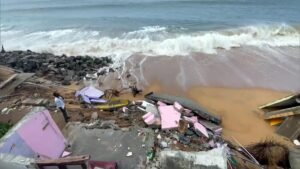
Why in news?
In recent days, Kerala’s coastal areas have witnessed a natural phenomenon known as Kallakkadal, resulting in the flooding of numerous houses and prompting authorities to open relief camps.
What is Kallakkadal?
- Kallakkadal, a term derived from Malayalam, translates to “ocean that arrives as a thief.”
- It refers to coastal flooding during the pre-monsoon season caused by swell waves on the southwest coast of India.
- These waves, originating from distant storms like hurricanes, travel thousands of kilometers until they reach the shore, often without precursor wind activity.
- The term was formally approved by UNESCO in 2012, acknowledging its significance in local communities.
Causes of Kallakkadal:
- Ocean swells, generated by strong winds in the southern Indian Ocean, are the primary cause of coastal flooding during the pre-monsoon season.
- The energy transfer from air to water during storms leads to the formation of high waves.
- In the recent instance, a low atmospheric pressure system over the South Atlantic Ocean resulted in swell waves up to 11 meters in height, affecting the Kerala coast and Lakshadweep.
- This underscores the intricate interplay of meteorological conditions and oceanic dynamics that contribute to these events.
Distinguishing Kallakkadal from Tsunamis:
- Despite similarities in their impact on coastal regions, Kallakkadal and tsunamis are distinct phenomena. Kallakkadal is driven by ocean swells caused by distant storms, whereas tsunamis result from underwater disturbances, typically associated with earthquakes.
- While both can lead to devastating consequences for coastal communities, understanding this difference is crucial for accurate disaster preparedness and response.
- Early warning systems like the Swell Surge Forecast System play a vital role in providing timely alerts and mitigating the impact of Kallakkadal events.
Forecast and Mitigation Measures:
- INCOIS’s Swell Surge Forecast System provides advanced warning of Kallakkadal, enabling authorities to take timely precautionary measures.
- The forecast indicates the continuation of high waves for the next two days, primarily impacting Kerala and other western coast regions before gradually weakening.
- Coastal communities are urged to take precautions against sea erosion and ensure the safety of fishing vessels.
- Additionally, efforts to enhance coastal resilience through infrastructure development and community-based adaptation strategies are essential for mitigating the long-term impacts of Kallakkadal events.
Conclusion:
- Kallakkadal presents a unique challenge to coastal communities, characterized by sudden flooding without precursor wind activity.
- Through advanced forecasting systems and awareness efforts, authorities aim to mitigate its impact and safeguard vulnerable populations.
- Understanding the distinction between Kallakkadal and tsunamis is essential for effective disaster management, ensuring prompt response and minimal loss of life and property.
- As Kerala continues to grapple with the effects of Kallakkadal, proactive measures and community resilience remain paramount in confronting this recurring coastal phenomenon.
People also ask
Q1: What causes coastal flooding during the pre-monsoon season?
Ans: Coastal flooding during the pre-monsoon season is primarily caused by swell waves on the southwest coast of India. These waves are generated by distant storms like hurricanes and travel thousands of kilometers before reaching the shore.
Q2: How is coastal flooding different from a tsunami?
Ans: Coastal flooding, including Kallakkadal events, is caused by ocean swells generated by distant storms. In contrast, tsunamis result from underwater disturbances, typically associated with earthquakes. While both can lead to flooding, they have different causes and characteristics.
Q3: What leads to the formation of ocean swells?
Ans: Ocean swells are primarily formed by strong winds in the southern Indian Ocean. During storms, energy is transferred from the air to the water, resulting in the formation of high waves that can travel long distances before reaching the coast.
Q4: Are there any warning systems in place for coastal flooding?
Ans: Yes, the Indian National Centre for Ocean Information Services (INCOIS) has implemented the Swell Surge Forecast System, which provides advanced warning of coastal flooding events. This system helps authorities take timely precautionary measures and mitigate the impact on coastal communities.
Your point of view caught my eye and was very interesting. Thanks. I have a question for you.
Your article helped me a lot, is there any more related content? Thanks!